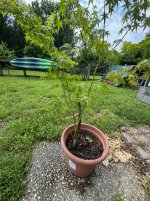First lesson in Bonsai: Bonsai is not immediate. Good trees take many years to produce so be prepared to be here for the long haul.
Second lesson: Much of what we do is seasonal and seasons vary according to where you are on this globe. Your tree appears to have new leaves so I'm guessing somewhere in northern hemisphere but that's still a vast range of climate zones. For better advice that suits your area, please add a location to your user profile. That saves having to type it in each time you post here.
To your particular tree:
It appears to have recovered and growing well again. Good!
You can remove the dead part of the trunk. Dead is dead and it will not grow again so better off gone. After the dead part is gone it should be easier to see what you have to work with.
The next part depends what you want from your Japanese maple bonsai. There are 2 basic choices:
1. Quick and dirty 'mallsai'. This is a smaller bonsai, usually with skinny trunk and random branches to make a canopy. Looks more like a 'bonsai' than a real tree.
2. Longer term higher quality bonsai. This is where we try to develop a bonsai that looks like a real tree and, especially, a real, old tree. Usually involves allowing the tree to grow big to develop a thick trunk then developing branches and finally ramification to represent the twigs and canopy of the tree. It is not unusual for us to plant small saplings in the garden for 3-10 years to allow faster growth then chop back to a stump. In the absence of garden space, larger pits can be utilised to allow the necessary growth. Another strategy is to develop the tree in a pot but allow 10-20 years for slower development.
Most beginners want something 'bonsai' to show they are, in fact, a bonsai afficionado. There's no harm in having a couple of type 1 'bonsai' while you are developing some better type 2 trees.
Let us know where you hope to go with this particular tree and we can probably help steer in that direction.




